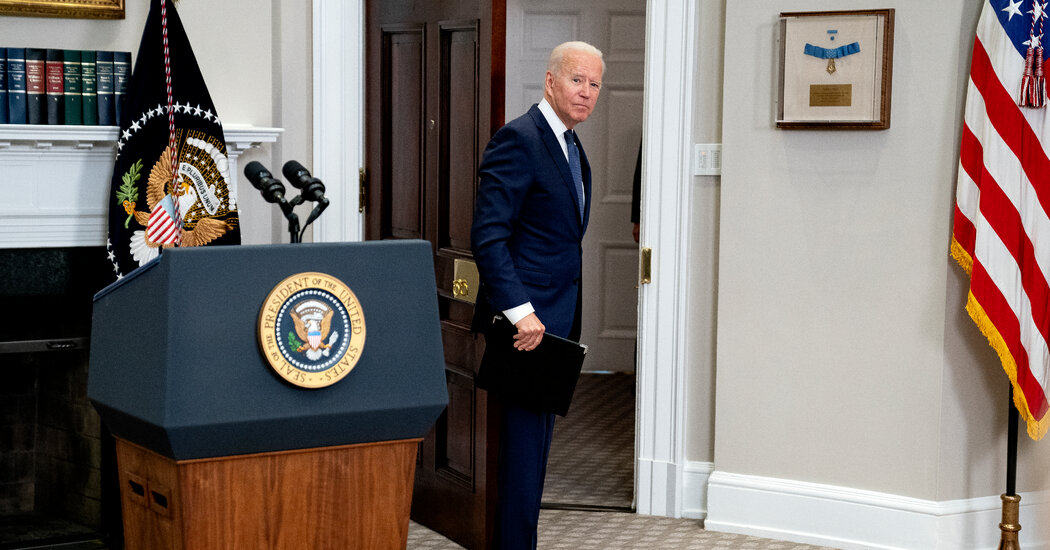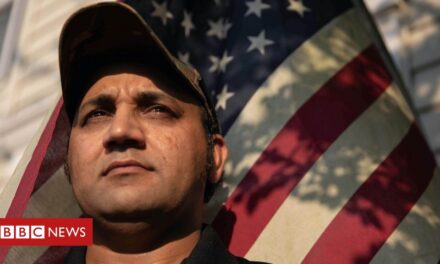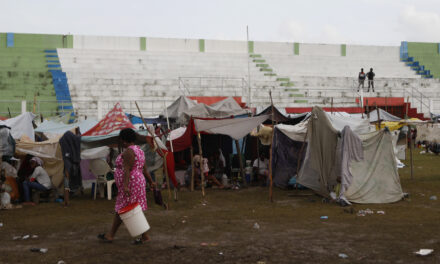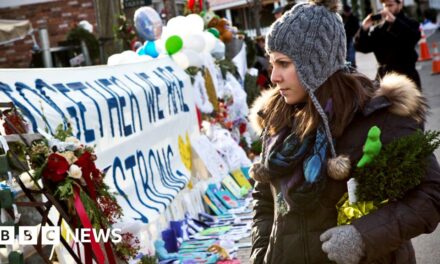
Pressure Grows on Biden to Extend Afghan Withdrawal Deadline


As the evacuation from Afghanistan plunged more deeply into chaos and violence, President Biden is considering extending the deadline for U.S. troops to withdraw, amid a groundswell of pressure from global leaders and veterans concerned that a security vacuum could risk lethal consequences.
Violent clashes at Kabul’s airport on Monday reinforced fears that the American withdrawal will aggravate the already precarious security situation. The German military wrote on Twitter that a member of the Afghan security forces had died in a firefight with unidentified attackers in the early hours. It did not specify which group the Afghans were affiliated with.
Three other members of the Afghan forces were wounded in the skirmish outside the airport’s North Gate, it said. U.S. and German soldiers were also drawn into the fight but were not harmed.
In recent days, the United States has scrambled to control the mayhem at the airport as thousands of Afghans try desperately to flee the Taliban, with surging crowds turning deadly. Britain’s Defense Ministry, which has troops at the airport, said on Sunday that seven Afghan civilians had died in the crowds, where people have been trampled to death, including a toddler.
Mr. Biden said on Sunday that his administration might extend his Aug. 31 deadline, and he pledged that all evacuated Afghan allies would be given a home in the United States after they are screened and vetted at bases in other countries.
“We will welcome these Afghans who have helped us in the war effort over the last 20 years to their new home in the United States of America,” he said in remarks from White House. “Because that’s who we are. That’s what America is.”
But the Taliban have made it clear that an extension of the U.S. deadline for troop withdrawal would be unwelcome. “They should finish the evacuation by Aug. 31 as they have promised,” Mohammad Naem, a Taliban spokesman in Qatar, said on Monday.
Leaders of the Group of 7 nations will hold a virtual meeting on Tuesday to discuss the increasingly dangerous situation. Prime Minister Boris Johnson of Britain, which holds the group presidency this year, is expected to broach the issue of the retrenchment as some inside Britain call for sanctions against the Taliban.
Beyond fears that the Taliban are regressing to their past behavior of violent repression, there are also worries among national security officials that the American withdrawal could create a new and ongoing threat, including ISIS terrorists regaining a foothold in the country.
“It is vital that the international community works together to ensure safe evacuations, prevent a humanitarian crisis and support the Afghan people to secure the gains of the last 20 years,” Mr. Johnson wrote on Twitter on Sunday.
U.S. military veterans have also pressed the White House not to abandon its resolve to provide a safe exit for American citizens and their Afghan allies. Dozens of organizations representing the military and veterans sent to a letter to the White House on Monday requesting a meeting with Mr. Biden to discuss the issue.
With Afghanistan becoming a potent emblem of American retrenchment in the world, Vice President Kamala Harris met with leaders on Monday in Singapore, the first stop in a trip to Southeast Asia that is aimed at bolstering ties in the region.
The Biden administration has made Asia a centerpiece of its foreign policy, hoping to build stronger ties there to counter an increasingly assertive China. But Ms. Harris’s senior aides have faced questions about whether the haphazard withdrawal from Afghanistan could undermine the administration’s diplomatic efforts.
The timing and optics of Ms. Harris’s trip to Vietnam, where she will arrive on Tuesday, are particularly awkward, with scenes of desperate Afghans at Kabul airport stirring memories of another fraught war.
In just over a week since the Taliban seized control of Afghanistan, the military has evacuated 28,000 people, Mr. Biden said, and he suggested that the military had expanded the secure perimeter around the airport.
Many fear for safety of those left behind, among them the roughly 3,400 Afghan U.N. staff members in Afghanistan, especially the women. Some have expressed worry that the Taliban and their extremist allies will target them because of their foreign affiliation.

Desperate people fleeing Afghanistan face dangerous crowds, vanishingly rare plane seats and Taliban fighters issuing beatings. But those lucky enough to leave can be consumed by feelings of despair for the country they left behind.
As thousands of Afghans scramble to leave, Samiullah Mahdi, a lecturer at Kabul University, said the attempted exodus was spurring a sense of shock, fear and alienation for people who have fled the Taliban takeover.
“Afghanistan is not the same anymore,” said Mr. Mahdi, who worked as a journalist for Tolo News, Afghanistan’s popular news outlet. “We are not the same anymore.”
He managed to flee a few days before the collapse of Kabul and asked that his location not be revealed because he feared for his safety. Now, he said, he was overcome by the sense of becoming a permanent refugee.
“We have no home to return to,” he said.
In recent days, the situation at the airport has grown increasingly dangerous for people trying to flee the Taliban. The large crowds have become unruly and in some cases deadly. Fears of attacks have grown.
Mr. Mahdi said he had heard harrowing accounts of people trying to escape. He said a colleague who suffered a broken arm after being beaten by Taliban fighters had not been given medical attention until he was evacuated.
The days since Kabul’s collapse have felt more like centuries, he said. A friend left in Kabul, where many people have remained cloistered inside for fear of Taliban retribution, described it to him as “a city of ghosts.”
“Even during the light of the day you feel like it’s dark. That kind of depression is governing the city,” Mr. Mahdi said. “People fear that the international community has given up on Afghanistan and they will one day recognize this regime change in the country.”
There was also an overwhelming sense, he said, that the advances of the past two decades, the liberalization of the press and the flourishing of women’s rights now threatened to unravel. “You have tears in your eyes, and you cannot hold it together,” he said. “It’s grieving, it’s anger, it’s hopelessness.”
When the Taliban ruled Afghanistan in the past, they imposed a harsh version of Shariah law, barring women from working outside the home or leaving the house without a male guardian, eliminating schooling for girls and publicly flogging people who violated the group’s morality code.
Mr. Mahdi said that the Taliban were already displaying their past tendencies and had asked private and public universities to segregate people by gender, using only female lecturers and professors for female students. But he said universities were struggling to find enough instructors, and he feared that they would be asked to abolish classes for women.
“It’s a lot of pain when you feel like everything that you tried and tried to build and love to work on is taken away from you,” he said.

Facing rising pressure over the United States’ haphazard withdrawal from Afghanistan, Vice President Kamala Harris said on Monday that the Biden administration was “singularly focused” on evacuating American citizens and Afghan allies.
Ms. Harris’s comments, at a news conference in Singapore, came at the start of her weeklong trip to Southeast Asia that is aimed at strengthening economic ties and countering China’s growing sway in the region.
Instead, her joint news conference with Lee Hsien Loong, Singapore’s prime minister, was dominated by questions about the chaotic execution of the withdrawal, which has prompted criticism from lawmakers on both sides of the aisle and leaders from around the world.
“Right now we are singularly focused on evacuating American citizens, Afghanistan who worked with us and Afghans who are vulnerable, including women and children,” Ms. Harris said. “That is a singular focus at this time.”
The remarks came after the White House detailed a series of new agreements with Singapore to bolster partnerships to address climate change, cyberthreats and the pandemic. Ms. Harris has also said the administration is focused on working with Southeast Asian nations to address supply-chain issues, including a global shortage in semiconductors that are used to build cars and computers. More broadly, the trip is part of the Biden administration’s goal to refocus its national security strategy on competing with the rising influence of China.
Still, the beginning of her trip has been overshadowed by the widely criticized exit of American troops from Afghanistan. The military has evacuated tens of thousands of people from the Afghan capital since Aug. 14, although thousands of Americans and Afghan allies remain in limbo. Thousands of Afghans seeking to escape the Taliban have rushed to the airport amid violence and several deaths.
Standing alongside Mr. Lee, Ms. Harris said her presence in Singapore, as well as the agreements reached during the visit, should assure allies that the United States remains a credible partner.
“I am standing here because of our commitment to a longstanding relationship, which is an enduring relationship, with the Indo-Pacific region, with Southeast Asian countries and, in particular, with Singapore,” Ms. Harris said.
After the meeting with the two leaders, Mr. Lee said he had offered to send one of Singapore’s military planes to assist in the effort to evacuate Afghan interpreters, guides and others who assisted or worked for the United States. Ms. Harris said the United States would follow up on the offer.
“We hope Afghanistan does not become an epicenter for terrorism again, and post-Afghanistan in the longer term, what matters is how the U.S. repositions itself in the Asia Pacific, engages the broader region and continues the fight against terrorism,” Mr. Lee said.
In what is likely to be a reprieve for Americans living in Singapore and U.S. businesses looking to continue work in the region, Mr. Lee also said he was now able to “to contemplate vaccinated, safe, quarantine-free travel” with other nations and that would continue conversations with the United States on easing pandemic travel restrictions.
“It’s something which we have strongly in mind, because it’s important for Singapore as a hub to be able to reopen and to operate safely, and for people to travel back and forth to do business and to keep ourselves connected with the world,” Mr. Lee said. “And the U.S. is one of the countries which we will be pursuing these conversations with.”

Last week, former President Hamid Karzai stood outside his home in Kabul to record a video message, surrounded by his daughters, and said that he would stay in the Afghan capital with his family to try to coordinate with the Taliban for a peaceful transition.
But even as he has tried to positioned himself as a mediator at this crucial moment, his ability to play that role is tenuous. By the time Mr. Karzai appeared in a second video — recorded in the garden of the former foreign minister Abdullah Abdullah — he appeared less confident and his speech was stilted. Mr. Abdullah stood beside him in silence.
Mr. Karzai found refuge with Mr. Abdullah, two Afghan officials said on Monday, after the Taliban disarmed his guards and took over security of his compound several days ago.
Mr. Karzai, who since retiring in 2014 has lived in a well-guarded government house beside the presidential palace, remained in Kabul after many officials left. He had said that he was forming a council of Afghan leaders to negotiate an inclusive interim government with the Taliban.
But he and Mr. Abdullah are in an increasingly strained situation, said Muslem Hyatt, a former military attaché for the government of Afghanistan to London. The pressure on Mr. Karzai and Mr. Abdullah raises questions about their ability to work freely to help form a new government despite Taliban suggestions that former officials would be pardoned as the group seized control of the country.
Saad Mohseni, the director general of MOBY Media Group, which owns the independent news channel Tolo TV, said that he had been in touch with Mr. Karzai and Mr. Abdullah and that his impression was that the meetings between the Taliban and the former leaders were little more than show.
“They are consulting them on general things,” he said — “national unity, reassuring the Afghan public, building national consensus, but nothing substantive on the future government.”
An Afghan official who is outside the country said he had been told that Mr. Karzai’s wife and children were also with him at Mr. Abdullah’s house.
Both Mr. Karzai and Mr. Abdullah were on a Taliban list of wanted people, and former government officials said they were concerned for their safety as the Taliban intensify their search for members of the Afghan government security services.
“We are very worried,” Mr. Hyatt said, noting that he had learned the circumstances of the takeover of Mr. Karzai’s home from people still in Kabul. An aide to Mr. Abdullah reached by telephone said that he was not available to speak to the news media.

As Australia scrambles to evacuate citizens and visa holders from Kabul, it has also started an advertising campaign to deter Afghan refugees from trying to reach Australia by boat, promising that they will have “zero chance of success.”
“Australia’s strong border protection policies have not and will not change,” Karen Andrews, Australia’s minister for home affairs, said in a 30-second video uploaded to a government YouTube channel on Monday. “No one who arrives in Australia illegally will ever settle here. Do not attempt an illegal boat journey to Australia. You have zero chance of success.”
The notice is a reminder of the nation’s strict stance on asylum seekers and an offshore detention policy that has been widely criticized by rights groups in recent years. The video message is the latest in a series created by the government since 2013 to discourage attempts to reach Australia by sea.
In an emailed statement, Ms. Andrews reiterated that people who arrive by boat will not be resettled in Australia.
“The Australian government has granted more than 8,500 visas to Afghans under Australia’s humanitarian program since 2013,” she said. “These people arrived legally, on a valid visa issued by the Australian government.”
Australia has pledged to take in 3,000 Afghan refugees within its existing annual allocation of humanitarian visas, not including Afghans employed by the Australian government who are eligible for other visas. Prime Minister Scott Morrison suggested last week that this number could be increased, calling it “a floor, not a ceiling.”
The government has said it will not ask Afghans already in Australia on visas to return to their native country while the situation there remains fraught.
The video follows controversy last weekend when Australian news outlets reported that over 100 Afghans who worked as guards at Australia’s embassy in Kabul had been rejected for a specialty visa and told to “contact a migration agent” because they were contractors and not directly employed by the embassy.
Hours after that was reported, the government said the workers had been approved for humanitarian visas.
On Monday, Mr. Morrison said that 470 Australians, Afghan visa holders and citizens of allied countries had been evacuated from Kabul to Australia’s military base in the United Arab Emirates on Australian flights overnight. He said this took the total number of people evacuated from Kabul by Australian forces, with the help of the forces from the United States and Britain, to over 1,000.
A repatriation flight from the U.A.E. also landed in Melbourne, carrying 175 people who had been evacuated from Afghanistan. That followed another flight that landed in Perth on Friday, carrying 94 people.

The Taliban have reached out to former President Hamid Karzai and to Russia in an attempt to fulfill their pledge to form an “inclusive” government and defeat holdouts against their rule, amid deadly mayhem outside Kabul’s airport, with thousands of terrified Afghans trying to flee.
Little in the Taliban’s history suggests any readiness to compromise on their harsh Islamist principles or to share power, but the United States has warned the militant group that going it alone will result in continuous conflict and isolation. In this context, Mr. Karzai, who led the county from 2001 to 2014, has tried to put himself forward as a mediator, albeit one under increasingly strained circumstances.
Mr. Karzai, 63, who as president fell out with the United States over American drone attacks, corruption accusations and other issues, has met with Taliban leaders, including Khalil Haqqani, whom the United States has designated as a terrorist. Mr. Karzai is also working closely with Abdullah Abdullah, the head of the former Afghan’s government’s peace delegation.
A Taliban leader described as the acting governor of Kabul talked over the weekend with Mr. Karzai and Mr. Abdullah. A growing number of senior Taliban have been seen in Kabul in recent days to discuss the shape of the next government, among them Mullah Abdul Ghani Baradar, the Taliban’s chief diplomat, who was a senior official in the group’s government in the 1990s.
A delegation of Taliban leaders also visited the Russian Embassy in Kabul, asking officials there to pass along an offer of negotiations to a group of Afghan leaders holding out in northern Afghanistan, the Russian ambassador, Dmitri Zhirnov, told Russian television on Saturday.
Mr. Karzai’s position is tenuous. Both he and Mr. Abdullah were on a Taliban list of wanted people, and former government officials said they were concerned for their safety.
How the United States will view Mr. Karzai’s re-emergence is unclear. So, too, is whether Afghans will be convinced by the sudden professed moderation of the Taliban, whose oppression of women and brutality have been hallmarks of their rule.
A week after the Taliban overran the country and the two-decade long American attempt to shape a democratic Afghanistan collapsed, there was no sign of any cabinet taking form.

Defense Secretary Lloyd J. Austin III has ordered six commercial airlines to provide passenger jets to help with the growing U.S. military operation evacuating Americans and Afghan allies from Kabul, the Afghan capital, the Pentagon said on Sunday.
Mr. Austin activated Stage 1 of the Civil Reserve Air Fleet, created in 1952 after the Berlin Air Lift, to provide 18 airliners to help ferry passengers arriving at bases in the Middle East from Afghanistan, John F. Kirby, the Pentagon spokesman, said in a statement.
The current activation is for 18 planes: four from United Airlines; three each from American Airlines, Atlas Air, Delta Air Lines and Omni Air; and two from Hawaiian Airlines.
The Pentagon does not expect a major impact on commercial flights, Mr. Kirby said.
Capt. John Perkins, a spokesman for the military’s Transportation Command, said that the commercial airliners would begin service on Monday or Tuesday and that they would fly evacuees from the Middle East to Europe and from Europe to the United States.
Captain Perkins said in a telephone interview that the military had requested wide-bodied, long-haul aircraft capable of carrying several hundred passengers. He said that discussions had started with the airlines last week and that some carriers had volunteered planes for the evacuation. But, he added, the demand was great enough for Mr. Austin to order more airlines to honor their obligations under the reserve fleet program.
Civilian planes would not fly into or out of Kabul, where a rapidly deteriorating security situation has hampered evacuation flights. Instead, commercial airline pilots and crews would help transport thousands of Afghans who are arriving at U.S. bases in Bahrain, Qatar and the United Arab Emirates.
The commercial airlines would ease the burden on those bases, which are filling up rapidly as the Biden administration rushes to increase the number of flights for thousands of Afghans fearing reprisals from Taliban fighters.
From the bases in the Middle East, the airliners would augment military flights carrying Afghans to Germany, Italy, Spain and other stops in Europe, and then ultimately to the United States for many of the Afghans, officials said.
Scott Kirby, the chief executive of United Airlines, said on social media, “As a global airline and flag carrier for our country, we embrace the responsibility to quickly respond to international challenges like this one.”
“It’s a duty we take with the utmost care and coordination,” he added.
The airline noted that four of its Boeing 777 planes, which seat as many as 350 people, had been activated.
This is just the third time that the reserve air fleet has been used. The first was during the Persian Gulf war (from August 1990 to May 1991). The second was during the Iraq war (from February 2002 to June 2003).
For the evacuation mission, one of the largest the Pentagon has ever conducted, the military has expanded beyond its fleet of C-17s, the cargo plane of choice in hostile environments, to include giant C-5s and KC-10s, a refueling plane that can be configured to carry passengers.
Source: https://www.nytimes.com/live/2021/08/23/world/taliban-afghanistan-biden-news/


















